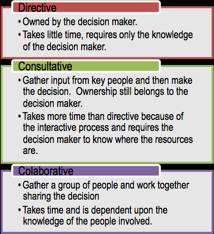Sort Articles:
Collaborative Decision Making
Written by: Lorraine Twombly
Published: February 2012
 Introduction to decision making…
Introduction to decision making…
If you read Ralph's or Craig's article already, you will notice that they took the first two styles (directive and consultative) to write about this month. The style I'm writing about takes the most time to process, and can be the most rewarding for the employees, team, or staff of any organization. This style is called collaborative.
Because the collaborative style is very team-like in its approach to solving problems, it is the most appreciated, especially among important decision-making initiatives that will affect the organization as a whole.
So, let's get collaborative...of all three decision making styles, the collaborative is the most time consuming, but also creates great, profitable businesses, when done right.
Some organizations have learned that this style works, especially, once the employees have figured out ways to get things accomplished quickly, effectively, and with lots of follow-up, meetings, and communications of all types. In our experiences, we have found that people like to work this way and these folks speak highly of their organizations, which strengthens their reputation locally, regionally, and in the world.
In our business we help organizations to change their culture from less power and role (which promotes the directive style) to more achievement and support. When this happens, decisions tend to be more consultative and then, as support becomes stronger, more collaborative in their decision-making style. These organizations collaborate very well because they structure their time and energy for maximum effort, and that means people working together and having a happier place to work, while meeting deadlines to customers, clients, vendors, and most of all employees. Including outside resources when necessary is smart and creates great service and modeling for them as well.
While collaboration works well for organizations that have figured out how to minimize the time and effort, it is safe to say that organizations need to account for the time it takes to use this style on a regular basis. Directive and consultative are probably needed (depending on the decisions that need to be made as you probably read in Ralph's and Craig's articles) to keep the organization heading in the right direction, and leaders need to know when best to use the three styles.
Here’s a quick synapsis of collaboration…
Ask the group (or another individual) for ideas and together you agree on what needs to be done.
- Ownership - The group is charged with the decision (they feel important and dedicated to the company).
- Advantages - Ownership and education is maximized, which means you will have high levels of involvement and commitment to the success of the decision and will try to do what’s best for the organization. Leaders and employees have a commitment to learning and growing in their organization.
- Disadvantages - Takes time, energy, and can feel like too many decisions by committee. Employees need to be continually educated and that may be a drain on resources, depending on the organization.
In summary…
- It takes more time to choose this style so, if you have time, you can include your team, staff, or employees when making important decisions that will affect the health of their organization.
- Employees and leaders need the training and education to truly be a collaborative decision-making organization.
- Leaders who embrace continuous learning as a way of life, tend to be the best at making collaborative decisions.
- It takes a leader who likes the team spirit to making decisions, so the employees will feel valued and contribute more effectively toward the health of the organization.
- It requires patience to use this collaborative style.
- The team, staff and employees have ownership in the decisions of their organization.
- Time and energy can be structured for maximum effectiveness when decisions are made by the people who work there.
Thanks for reading and hope to see you soon!
Lorraine Twombly
Austin Brown
mpho

